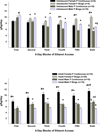Modeling binge-like ethanol drinking by peri-adolescent and adult P rats
- PMID: 21824488
- PMCID: PMC3183250
- DOI: 10.1016/j.pbb.2011.07.017
Modeling binge-like ethanol drinking by peri-adolescent and adult P rats
Abstract
Alcohol binge-drinking, especially among adolescents and young adults, is a serious public health concern. The present study examined ethanol binge-like drinking by peri-adolescent [postnatal days (PNDs 30-72)] and adult (PNDs 90-132) alcohol-preferring (P) rats with a drinking-in-the-dark-multiple-scheduled-access (DID-MSA) procedure used by our laboratory. Male and female P rats were provided concurrent access to 15% and 30% ethanol for three 1-h sessions across the dark cycle 5 days/week. For the 1st week, adolescent and adult female P rats consumed 3.4 and 1.6g/kg of ethanol, respectively, during the 1st hour of access, whereas for male rats the values were 3.5 and 1.1g/kg of ethanol, respectively. Adult intakes increased to ~2.0 g/kg/h and adolescent intakes decreased to ~2.5 g/kg/h across the 6 weeks of ethanol access. The daily ethanol intake of adult DID-MSA rats approximated or modestly exceeded that seen in continuous access (CA) rats or the selection criterion for P rats (≥5 g/kg/day). However, in general, the daily ethanol intake of DID-MSA peri-adolescent rats significantly exceeded that of their CA counterparts. BELs were assessed at 15-min intervals across the 3rd hour of access during the 4th week. Ethanol intake was 1.7 g/kg vs. 2.7 g/kg and BELs were 57 mg% vs. 100mg% at 15- and 60-min, respectively. Intoxication induced by DID-MSA in female P rats was assessed during the 1st vs. 4th week of ethanol access. Level of impairment did not differ between the 2 weeks (106 vs. 97 s latency to fall, 120 s criterion) and was significant (vs. naïve controls) only during the 4th week. Overall, these findings support the use of the DID-MSA procedure in rats, and underscore the presence of age- and sex-dependent effects mediating ethanol binge-like drinking in P rats.
Copyright © 2011 Elsevier Inc. All rights reserved.
Conflict of interest statement
None of the authors have conflicts of interest associated with this work.
Figures


References
-
- Adams N. Sex differences and the effects of tail pinch on ethanol drinking in Maudsley rats. Alcohol. 1995;12:463–468. - PubMed
-
- Adams M, Effertz T. Effective prevention against risky underage drinking—the need for higher excise taxes on alcoholic beverages in Germany. Alcohol Alcohol. 2010;45:387–394. - PubMed
-
- Bell RL, Kimpel MW, Rodd ZA, Strother WN, Bai F, Peper CL, Mayfield RD, Lumeng L, Crabb DW, McBride WJ, Witzmann FA. Protein expression changes in the nucleus accumbens and amygdala of inbred alcohol-preferring rats given either continuous or scheduled access to ethanol. Alcohol. 2006a;40:3–17. - PubMed
-
- Bell RL, McKinzie DL, Murphy JM, McBride WJ. Sensitivity and tolerance to the motor impairing effects of moderate doses of ethanol. Pharmacol Biochem Behav. 2000;67:583–586. - PubMed
Publication types
MeSH terms
Substances
Grants and funding
LinkOut - more resources
Full Text Sources
Medical

